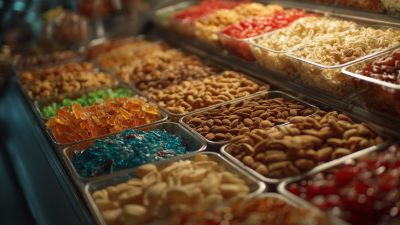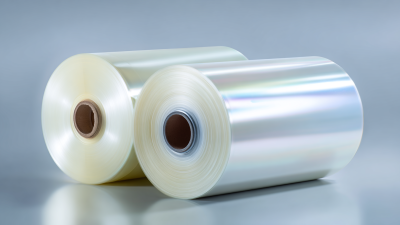The 138th Canton Fair in 2025 promises to be a pivotal event for the food packaging industry, showcasing groundbreaking innovations in Food Grade Film technologies. As consumer demand for sustainable packaging solutions continues to grow, the global food packaging market is projected to reach USD 500 billion by 2027, driven by advancements in materials that enhance freshness and safety. According to a recent industry report by MarketsandMarkets, the Food Grade Film segment alone is anticipated to register a CAGR of 4.5% over the next five years, reflecting increasing regulatory standards and consumer preference for eco-friendly options.

This year's fair will highlight the latest trends in biodegradable films and multi-layer packaging solutions that not only meet stringent food safety regulations but also contribute to environmental conservation. The confluence of innovation and sustainability in Food Grade Film at the Canton Fair will be crucial for stakeholders looking to stay competitive in this rapidly evolving market landscape.
At the 138th Canton Fair in 2025, innovative materials showcased for food grade films are redefining packaging standards in the food industry. With growing consumer demand for sustainable and safe packaging solutions, manufacturers are increasingly investing in advanced materials that enhance preservation while minimizing environmental impact. According to a recent report by Smithers Pira, the global market for food packaging films is projected to reach $52 billion by 2026, reflecting a CAGR of 4.2% from 2021. This growth is driven by innovations in biodegradable films and active packaging technologies that help extend shelf life and maintain food quality.
Among the breakthroughs displayed at the fair were bio-based polymers and multilayer films incorporated with antimicrobial properties. For instance, the application of polylactic acid (PLA) not only serves as a renewable alternative to traditional plastics but also provides a robust barrier against moisture and oxygen, which are vital in food preservation. Additionally, advances in nanotechnology are paving the way for food grade films integrated with nano-silver particles for enhanced safety. As manufacturers aim for compliance with global food safety standards, these innovations are imperative for meeting regulatory requirements and catering to eco-conscious consumers.
The 138th Canton Fair in 2025 highlights a significant focus on sustainability trends within the food packaging industry. As global awareness surrounding environmental issues continues to rise, the demand for eco-friendly packaging solutions has become more pronounced. Innovations in food-grade films are at the forefront of this shift, with manufacturers showcasing biodegradable and compostable materials that minimize waste and carbon footprints. These advancements not only cater to consumer preferences for sustainable products but also comply with increasingly stringent regulations on environmental impact.
At the fair, exhibitors are presenting a range of innovative food-grade films that utilize renewable resources, such as plant-based polymers, to create packaging that is both functional and environmentally responsible. The integration of smart technology within these films, which can help monitor freshness and reduce spoilage, further underscores the industry's commitment to sustainability. This synergy of technology and eco-consciousness not only enhances the consumer experience but also aligns with the broader goals of reducing plastic waste in food packaging. As insights from industry leaders converge at this pivotal event, it is clear that sustainability will remain a key driving force in the evolution of food packaging solutions.
| Dimension | Details |
|---|---|
| Material Type | Biodegradable Films |
| Key Features | Compostable, Recyclable, Reduced Carbon Footprint |
| Industry Applications | Food Packaging, Agricultural Films, Flexible Packaging |
| Market Trends | Increase in Demand for Sustainable Packaging Solutions |
| Challenges | Cost of Raw Materials, Performance Limitations Compared to Traditional Plastics |
| Innovative Technologies | Nanotechnology Enhancements, Bio-based Polymers |
| Consumer Awareness | Growing Interest in Eco-Friendly Products |
| Future Outlook | Increased R&D in Sustainable Films and Materials |
At the 138th Canton Fair 2025, the spotlight will be on emerging technologies that are revolutionizing the food grade film industry. Innovations such as biodegradable materials and advanced barrier properties are setting new standards for sustainability and food preservation. As consumer demand for eco-friendly packaging increases, companies are investing in research and development to create films that not only protect food but also minimize environmental impact. Materials like plant-based polymers and recyclable composites are leading the way in this transformation.
Moreover, technological advancements in production processes, such as nano-coating and enhanced extrusion techniques, are significantly improving the performance of food grade films. These innovations enable the creation of thinner, lighter films without compromising strength or protective qualities. As manufacturers adapt to these new technologies, they can offer solutions that meet strict food safety regulations while enhancing shelf life and product appeal. The integration of smart packaging features, including moisture indicators and temperature sensors, further exemplifies how technology is spearheading the evolution of food grade films, catering to an increasingly health-conscious and environmentally aware consumer base.

At the 138th Canton Fair in 2025, the spotlight is on food grade film innovations as key industry players unveil their latest advancements. Among the exhibitors are leading manufacturers showcasing eco-friendly films designed to enhance food safety and extend shelf life. These innovations not only meet rigorous industry standards but also reflect a growing trend towards sustainability in packaging solutions. With the introduction of biodegradable and compostable materials, companies are responding to consumer demand for environmentally responsible products.
When exploring these innovations, it’s essential to consider factors like material thickness, barrier properties, and compatibility with various food types. Additionally, attending live demonstrations can provide valuable insights into how these films perform under different conditions.
For those looking to stay ahead in the packaging industry, networking with other professionals at the fair can provide unique opportunities to collaborate and share ideas. Engaging with thought leaders and participating in panel discussions can offer a deeper understanding of current trends and future directions in food grade film technology.
At the 138th Canton Fair in 2025, the spotlight on food packaging innovations revealed significant consumer preferences that are shaping the industry. Attendees explored a variety of food-grade films designed to enhance food preservation and convenience. Eco-friendly materials and sustainable packaging solutions were particularly popular, reflecting a growing consumer demand for products that minimize environmental impact. Moreover, the trend towards resealable and easy-to-open designs indicates that convenience is a priority for today's shoppers.

When considering new packaging solutions, businesses should keep some tips in mind. First, prioritize the use of biodegradable materials to appeal to eco-conscious consumers. Additionally, incorporating user-friendly features can enhance customer satisfaction and encourage repeat purchases. Lastly, staying ahead of the trends by continuously researching consumer feedback ensures that products meet evolving preferences.
The fair also highlighted innovative technologies, such as smart packaging that can monitor freshness and safety. This aligns with consumers' increasing focus on health and quality, as they are willing to invest more in products that offer better protection and reliability. By integrating these insights, companies can better align their offerings with market demands and enhance their competitive edge in the food packaging landscape.






